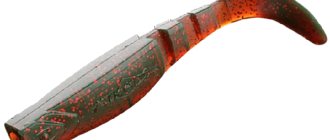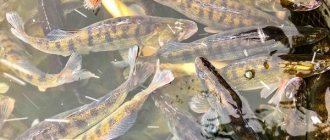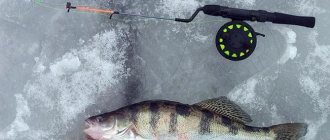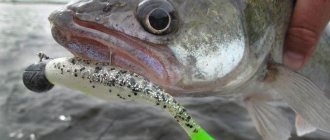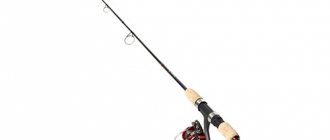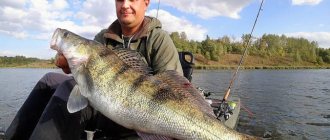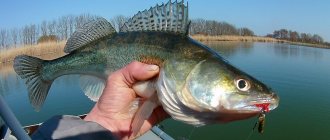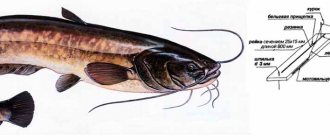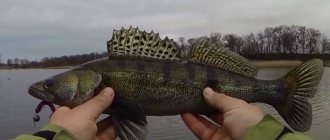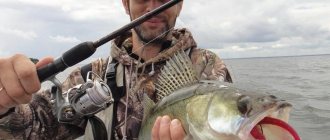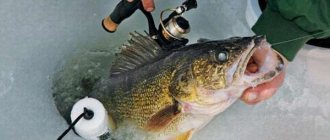Pike perch is a freshwater fish of the perch order, widely distributed in the waters of Asia and Eastern Europe.
Lives in the waters of the river basins of the Baltic, Black and Azov seas, the Caspian and Aral seas. Pike perch is also found in other fresh water bodies and desalinated waters - in the deltas of numerous rivers. Since the 60s of the last century, pike perch, through the efforts of ichthyologists, was brought to the Far East and settled in Lake Khanka. Here it developed rather slowly under pressure from local species of predatory fish. Now it is found in the Ussuri River and enters the Amur. We can talk about the presence of this species in the ichthyofauna of the Far East. The fish is quite large - data has been recorded according to which it reaches a weight of 15 kilograms with a length of a meter. The existence of larger individuals is not excluded. A characteristic feature is the presence in the mouth of hook-shaped teeth, curved inward, which exposes the pike perch as a predatory fish. It is noteworthy that the male has larger teeth than the female.
Nutrition and lifestyle
The diet of pike perch, a typical predator, is based on fish. Small individuals happily eat invertebrates. The fish is sensitive to the oxygen content in water, does not like muddy water and therefore is not found in silted waters.
It prefers clean sandy and sandy-pebble areas of the bottom of the reservoir. In warm weather, it mainly stays at depths of 5–7 meters, coming out to the shallows in the dark to hunt. It can be found in snags, because it is an ambush predator. Hiding in cover, he waits for a long time for the approach of the hunted object and attacks when he approaches. The object of the hunt is mainly narrow-bodied fish - bleak, gudgeon, sprat. It is preferable to use these same fish as live bait.
Methods for catching pike perch on a leash
Professional fishermen know many ways to fish for fanged lizards on a leash. Wiring is especially popular among fishermen of all formations. It’s worth taking a closer look at how to catch pike perch on a lead video, as well as a description of fishing techniques.
Classics of the genre. The fisherman goes ashore and casts. The load sinks to the bottom. Its sound on the surface attracts fish. She, in turn, swallows the bait. Pike perch is a bad hunter. He doesn't like to chase prey. Therefore, using the classic casting method you can get a good catch.
How to catch pike perch on a diverting leash? Using the uniform wiring method. This method is used in places where fish accumulate. It involves lowering the load to the bottom, smoothly dragging it and reeling in the fishing line. The activity of the fish allows for the use of small pauses and jerks during the retrieve.
There are several ways to catch pike perch, but the most effective way is to catch it on a spinning rod with a variety of baits, each season requiring its own.
Zander spawning
Pike perch spawns at a water temperature of at least 12°C , spawning yellowish eggs onto various substrates located at a depth of up to 6 meters. Once born, the fry feed on small invertebrates, and when they reach a size of 8–10 cm, they switch to feeding on fry of other species. This is facilitated by the rapid growth of pike perch compared to other fish species. At the age of about a year, pike perch can gain weight up to 800 grams. Pike perch becomes sexually mature at 3–4 years of age.
In winter, pike perch is most often found in bottom holes, wintering together with cyprinids - bream, carp, carp. It can also be caught in winter.
Some important tips for beginners
This fish is considered a very difficult hunting object compared to perch or pike. To make it easier for beginners to catch a fanged predator, here are some tips from experienced pikeperch fishermen:
- First of all, the pike perch should be found. Spare no expense, purchase an echo sounder, preferably with a navigator. This will allow you to look at the topography of the reservoir, determine the fanged sites, and mark the most catchy points. Even next season you can fish at the points marked in the navigator; the fanged sites do not change too much.
- Use exclusively narrow-bodied baits: long, fast-moving live baits, minnow wobblers, narrow-bodied spinners, oblong silicone. Try to make it most resemble the fanged one's natural prey. Live bait should also be narrow; wide-bodied fish, such as crucian carp, can be used during the short-term autumn feeding season.
- A metal or Kevlar leash suitable for pike will most likely scare away a more cautious predator. So try to do without it. As a last resort, use fluorocarbon with a diameter of 0.30 millimeters. It is also less noticeable in the water, and not every pike will bite it the first time. The length of such an insert should be twice the size of the bait used.
- Keep your hooks sharp. Don’t spare money, replace old ones with new ones, buy products from well-known manufacturers. A dull or weak hook is not able to penetrate a strong mouth. Sharpening at home is not comparable to chemical sharpening at the factory.
- Hook at any hint of a bite. It’s better to pull one more time than to miss the catch. Remember, the walleye holds the artificial bait in its mouth for only a few fractions of a second.
- In this case, the hook should be short and sharp, so that it can easily penetrate the mouth of the fanged one. Therefore, it is not recommended to make a lot of slack in the fishing line when fishing; you can simply miss a brief moment when a predator tries the bait on a tooth.
The nutritional value
Pike perch meat has unique nutritional properties that make it dietary. It has minimal fat content and contains up to 18% proteins . Meat contains a full set of 20 amino acids, 8 of which are essential - they are not produced by the human body. Contains many microelements necessary in the human diet.
There are many methods of fishing with live bait, but most of them are based on fishing from a boat. Spinner fishing, jig fishing, and live bait fishing are used. However, you can quite successfully catch this fish with live bait from the shore. One of the successful methods is fishing with a bait-and-snake bait.
Fishing for pike perch in reservoirs
- VK
To catch pike perch in reservoirs, there are three requirements - the presence of a boat (preferably with a motor, since you have to cover 10 - 12 km per day when searching), an echo sounder and the correct spinning rod. The first two are clear, I’ll explain about spinning. It must be long enough to throw loads of 12-20 g over 20 - 40 meters. And fast enough to cut through the bony pike-perch mouth. And so sensitive as to accurately register careful bites, especially on the waves. Content:
- HABITAT AND FOOD
- BITTING
- LURE
- WIRING GEAR
HABITAT
It is known that pike perch loves all kinds of irregularities on the bottom - these are drops into and out of the riverbed, mounds, deep-sea banks, local grooves, and snag boundaries. Other signs of the possible presence of pike perch are a hard sandy bottom, shell rock, pebble areas, or better yet, all together. And if there is a place where all or most of the above signs are present, then pike perch will appear there sooner or later.
BITTING
There are three conventional stages of pike perch biting.
The first stage of biting - and the rarest - is characterized by the vigorous activity of the prickly predator. He energetically and brazenly takes equally all jig baits offered to him, often swallowing them deeply. It has been noted that this stage is observed more often during periods of environmental stability.
The second stage of biting - and the most common - is when the pike perch, although it detects itself biting, does so somehow sluggishly and indistinctly. This stage occurs during high pressure and cloudy weather or during periods when the weather is unstable and changes dramatically. The same thing happens when there is strong roughness on the water or when there is a sudden release of water from a hydroelectric power station.
The third stage of biting - the saddest - is when the pike perch does not show itself in any way in the reservoir, as if it had died out. Moreover, this stage occurs at completely different times of the year and under different weather conditions. Even in consistently good weather. Here you have to leave with nothing, nothing can be done.
LURE
"SILICONE" IS SIMPLE. A group of classic lures with many adherents. All such baits have negative buoyancy. And it is not so important whether it is a worm-shaped twister, a “fish” or an imitation of a crustacean, the main advantage is their active “game” of their own.
Classic “silicone” works great in the summer, even at high water temperatures, when pike perch are most active in moving around the pond.
The advantages include low cost and wide distribution. As a result, a great variety of “accessories” are sold for these baits, but the most popular equipment option remains a hinged mounting - a “Cheburashka” weight, winding rings and a double (photo 1, below). It is perfect for active fangs, since the double provides a reliable hookup, and the swivel joint provides the greatest mobility of the bait. photo 1
But if we are talking about the second stage of biting - when the pike perch is not in the mood to swallow the bait, the simplest equipment option - on a standard jig head (photo 1, above) has certain advantages. And above all, because the fixed position of the hook provides incomparably greater implementation in cases where the pike perch covers the bait.
Priority is given not to jig heads of the “ball” type, but of the “boot” type, and photo 2 shows why. After all, pike perch loves baits that, upon contact with the bottom, float up invitingly, taking on the appearance of a feeding fish. And in the case of classic “silicone”, i.e. initially a sinking bait, the “boot” gives it the very correct position on the bottom.
photo 2
"SILICONE" IS Tricky. This group includes baits made from “edible rubber”, as well as floating “rubber” in all its variety. Such baits have not only an active “game”, but also buoyancy. Some baits in this group have their own positive buoyancy - for example, Zman (photo 3).
photo 3
Or they float thanks to an air capsule in the body - like Mann's Samba, the body of which cannot be pierced with a hook so as not to damage this same capsule, but it is proposed to clamp it along special grooves between the retracted forends of the double (photo 4).
And, of course, the smells of flavored “edibles” cannot be written off - it’s not for nothing that it has recently gained such popularity. photo 4
“FOAM POLONS”. This group of baits has been used for catching pike perch for decades (photo 5).
photo 5
Foam rubber “fish” with uniform wiring are devoid of any “game”, but with stepped wiring they simply come to life. Thanks to the air bubbles remaining inside the body, the “foam rubber” has positive buoyancy, so it takes a vertical stance in the water. Let's add to this the noise effect that is certainly created during the fall when water passes through the pores of the bait - as a result, we get an absolutely unique thing. It is believed that the “foam rubber” is a cold water bait, respectively, for passive fish.
POLYURETHANE FOAM LURES. Like “foam rubber”, a unique class of baits (photo 6). And they are also completely devoid of their own “game” with uniform wiring, and on the “steps” they simply come to life.
photo 6
The movements of the “Mandula” (as these baits are also called) are similar to the fuss of a lamprey larva or some kind of shrimp - it has an irresistible effect on pike perch.
Its main advantage is that the tail is equipped with a miniature three-piece, to which the pike perch clings in four cases out of five, especially during passive biting, when it bites the tails of the bait. The disadvantages of the bait are increased grip and considerable cost (labor-intensive production). However, it is excellent for passive pike perch, especially in the fall.
WIRING GEAR
The classic version of stepped wiring: two turns of the coil - pause - two turns - pause. But an interesting question: what does pike perch like more - the moment the bait falls or, conversely, the rising phase, or maybe touching the bottom? It is important to understand that each type of bait has its own specifics. For example, classic “silicone” works well at high amplitude “steps”, when the bait has a longer free fall or rise phase. Therefore, you need to make 2 - 3 full turns of the reel handle.
“Foam rubber” or “Mandula”, on the contrary, perform better on a short “step” with a less amplitude “game” and more frequent contacts with the bottom. Therefore, we shorten the “step” by making only one full turn of the handle during the winding phase.
When fishing near the shore in a strong current, fishing with a reel is more effective, and in weak currents, fishing with a rod. The weight of the jig head should be minimal, but sufficient for each specific location.
The bait is cast at an angle downstream and taken in short steps (1-1.5 m) in an arc towards the shore.
If along the route the bait passes through a riffle or a coastal edge, then success is guaranteed (Fig. 1 and 2). Fig 1. Wiring along the riffle
Fig 2. Wiring along the coastal edge
With the onset of morning, pike perch leave the shallow water and take a strong position on the riffles. But you can’t fish from a boat - the spawning ban is still in effect. The most avid ones pick up long-range gear and continue the hunt, looking for pike perch sites to which they can throw bait from the shore.
For fishing from the shore, the most effective equipment is with a heavy sinker and a streamer made of goat hair, which anglers call a “beard” (photo 7).
Long-range jig baits mounted on a “eared” weight are also used. This type of bait installation significantly increases the casting distance compared to equipment on a conventional jig head (photo 8). Photo 7. Rigs with a heavy sinker and a floating streamer for long-distance fishing.
a) in still water, b) in the current Photo 8. Twisters and foam fish
At the beginning of summer, when the ban on fishing from a boat is lifted, pike perch have already moved to their “summer apartments” at medium depths near the riverbed. Here he will remain until late autumn, in the pre-winter period he will “slide” into the wintering pits in order to repeat his routine for the year again next year.
Related articles:
Sliding floats - fishing features
Fishing in the city
Catching catfish using kwok
Methods of fishing with bottom rigs
Where to catch pike perch from the shore
A prerequisite for successful live bait fishing is the current, and the stronger the better. The bottom should be free of bottom sediments, rocky or sandy - both are favorite hunting and habitat areas for pike perch. The depth in these places is 4–6 meters .
With the onset of darkness, he comes out of the pits to chase the fry. The bites will continue intermittently throughout the night. Fishing at night requires the mandatory use of beacons - light or sound.
Having taken care of catching live bait on pike perch for bait, and these should be fish from this reservoir - minnows, small roach, bleak - we prepare the gear for fishing.
The nature of the gear is bottom-based - the live bait will be above the bottom, attracting pike perch with its game.
Installation of bottom fishing rod equipment for pike perch:
- A rod - for pike perch, you definitely need a fast action, quite rigid, about 2.5 meters long. This is due to the peculiarity of the body structure of the pike perch - it has a bony palate, the flexibility of the rod should not prevent the hook from piercing the body of the fish, including when hooking.
- Reel – select a fairly powerful one, spool 2500-3000. The main line is preferably a braided cord with a cross-section of 0.3 mm.
- Leashes - you can use strong fishing line, but it is better to use Kevlar or tungsten leashes, since pike may bite on this tackle.
- The load must be selected depending on the strength of the current. It must ensure the stability of the gear. As a rule, a load weighing 60 grams is quite enough.
- It is better to use hooks No. 10, always with a long shank; doubles and treble hooks are also suitable.
- The rocker arm is a steel wire with a cross-section of approximately 0.5 mm. There are rings at the ends. About a quarter of the length is bent at an angle of 90° by twisting it into a spring by 1.5 - 2 turns. Functionally, it ensures the play of live bait in the current, and also removes the leash from the main line to avoid twisting when casting. It must be secured through rings; the movement of the leash is limited by two stop beads. This fastening increases the sensitivity of the tackle during a bite.
Overview of spinning equipment
The scheme for selecting spinning equipment includes at least four stages: choosing a rod, reel, fishing line and lure with bait.
Rod
Coil
The reel is a very mobile mechanism, and during intensive use, plastic parts and low-quality composite are the first to wear out.
fishing line
Monofilament of increased thickness (section) gives way to braided line. A rigid cord consisting of braided fishing lines is not inferior to monofilament in terms of sensitivity to the bite of small fish. Clear bait placement and effective hooking are guaranteed. The general characteristics of the cord and monofilament have become almost indistinguishable. Thin fishing lines are woven into a cord, the total thickness of which does not exceed 0.3 mm. The color of the line does not matter to the fish, but when there is excitement on a river or lake, bright colors are more visible to the fisherman.
Lures
Recessed wobblers with oscillations performed using the crank and fet method work throughout the fall.
In addition to the baits listed above, the following are also used for catching pike perch:
Fishing technique
Using more than 3 fishing rods is ineffective.
You need to place them as close to each other as possible and be in close proximity yourself. The pike perch bite is sharp and decisive . Once the strike has occurred, control the behavior of the rod end. The tip returning to its original position indicates that the hook did not occur. The tackle needs to be pulled out and the live bait changed (see video).
If the tip of the rod is bent, but is calm - the pike perch has taken the bait and is holding it in its mouth, but has not yet hooked it - with a sharp movement, hook the fish and remove it. To increase efficiency, you can attach another double or hook to the rocker arm.
